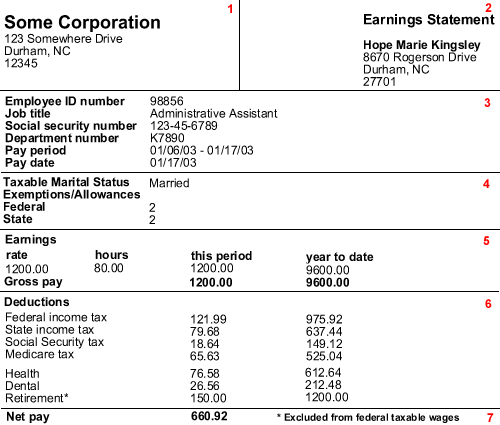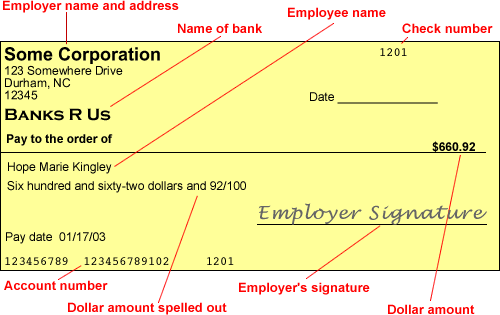Workplace Basics
Understanding Your Pay, Benefits, and Paycheck
Introduction
By the end of this lesson, you should be able to:
- Differentiate between gross income and net income
- Recognize commonly offered employee benefits
- Identify the importance of benefits
- Identify deductions on a paycheck
- Identify the parts of a detachable paycheck
- Understand direct deposit advice
The difference between gross and net pay
What is gross pay?

When you were hired, you agreed to be paid an annual salary or an hourly rate. This amount of money is called gross pay. Gross pay is the amount of money you make before certain deductions are taken out of your paycheck. Although it varies by employer, most employees receive their paychecks monthly, bi-weekly, or weekly.
Scenario:
Nick earns an annual salary of $36,400. Because Nick is paid weekly, his gross pay per paycheck is $700. However, this figure doesn't represent Nick's actual take-home pay. Why?
Answer:
Nick doesn't take home $700 per week because of the deductions taken out of his paycheck.
What is a deduction?
A deduction is money that is taken out of your paycheck for employee benefits, such as insurance, retirement and other preauthorized plans, and taxes.
What is net pay?
Net pay is the amount of money you take home after deductions are made. Deductions cause you to take home only about 70 to 80 percent of your gross pay.
What are employment benefits?
If you are eligible to receive employment benefits, you're lucky. In addition to your salary, employment benefits are considered part of your total pay package. In most cases, employees pay for at least a portion of their benefits, but your employer may pay for a fairly large portion of them as well. How much your employer expects you to contribute toward your benefits may change from year to year as benefit prices change.
Some common benefits include:
- Health/dental/vision insurance.
Health insurance helps cover the high cost of medical care. Some employers pay for such benefits entirely, whereas most employers pay a portion and the employee pays a portion, which comes out of their paychecks. - Retirement/pension plan.
Retirement plans such as 401(K) and 403(B) plans are an excellent way of saving for retirement, with an added benefit of deferring on income tax. The amount of money you decide to put into your plan comes out of your paycheck before income taxes are taken out. Some employers reward their employees with cash for participating in such programs, while some employees fund such plans on their own. - Life insurance.
In the event of your death, life insurance provides money for a beneficiary, usually a family member. This money is generally used to cover essential expenses and other financial needs. Many employers pay for a minimum amount of coverage. Employees may have the option of contributing money to increase the level of coverage. Deductions are commonly taken out of each paycheck. - Disability insurance.
This benefit pays lost income to an employee due to extended illness or disability due to an accident. Some employers offer a minimal amount of coverage, such as worker's compensation. Disability insurance coverage varies greatly from state to state. If your state or employer doesn't offer disability insurance, you can purchase a plan to suit your needs.
Understanding your paycheck
There are two parts to a paycheck: the check stub—sometimes called an earnings statement—and the paper check.
Below is an example of the check stub portion of a paycheck.

- Section 1 (employer information)
This section contains your employer's name and address.
- Section 2 (employee information)
This section contains information about you. It includes:
- Your name
- Your current address on file
- Section 3 (employee's job information)
This section contains information about your current job. It includes:
- Your employee ID number
- Your job title
- Your Social Security Number
- The department whose budget is paying your wages
- The pay period for which you are receiving payment
- The pay date
- Section 4 (employee tax data)
This section details your current tax filing status for both federal taxes and state taxes. It includes:
- The marital status you claimed on your W-4
- The number of allowances you have claimed
- Section 5 (employee hours and earnings)
This is a description of what you are being paid for, your pay rate for the current pay period, and the amount you are receiving in gross pay. If you are being paid hourly, the amount of hours for which you are receiving pay is also listed in this section.
There are two columns in this section: one for the current pay period, and one for the year to date.
- Section 6 (employee deductions)
This section describes each deduction that is withheld from your gross pay. There are two columns in this section: one for the current pay period, and one for the year to date.
These deductions will include:
- Federal income tax
- State income tax
- Social Security tax
- Medicare tax
- Additional taxes (some states charge other taxes such as state disability and/or other unemployment benefits)
Other possible deductions include:
- Health/dental/vision
- Retirement or pension plan
- Life insurance
- Disability insurance
- Child support (if you are delinquent on your child-support payments, some states will deduct them directly from your paycheck)
- Section 7 (employee net pay)
This section includes your net pay for the pay period.
Understanding your paycheck
Below is an example of a detachable paper check portion.

What is direct deposit?
Some employers offer their employees the added benefit of direct deposit. Direct deposit allows employees to deposit their paychecks into their checking or savings accounts. Aside from being convenient—i.e., less trips to the bank—paychecks are often deposited into personal accounts hours earlier than regular checks.
If you choose to accept the option of direct deposit, you will provide your employer with the name of your bank, your bank account number, a voided check, and some other personal information.
After direct deposit takes effect, you'll receive a paper check stub and a direct deposit advice slip in place of an actual check. Direct deposit advice slips somewhat resemble real checks but have the words "THIS IS NOT A REAL CHECK" and "NON-NEGOTIABLE" printed on them.

Please note the deposit date on your direct deposit advice slip. This is the bank business date your money will be deposited to your account. Banks add direct deposits at different times based on their procedures.
- 4 Types of Health Plans: How They Compare: This article from WebMD explains many of the basic terms you'll see on health insurance forms from your employer.
- Life Happens: This website by a consortium of insurance companies offers useful articles and tools on disability and life insurance.
- What You Should Know About Buying Life Insurance: This downloadable pamphlet by the American Council of Life Insurers provides a detailed explanation of how life insurance works.
- ReliaQuote: This online insurance service markets and sells life insurance policies online.
- Internal Revenue Service (IRS): Search the IRS website for more information on Social Security and Medicare.
- Book: Your Paycheck by Rena J. Pirsos


